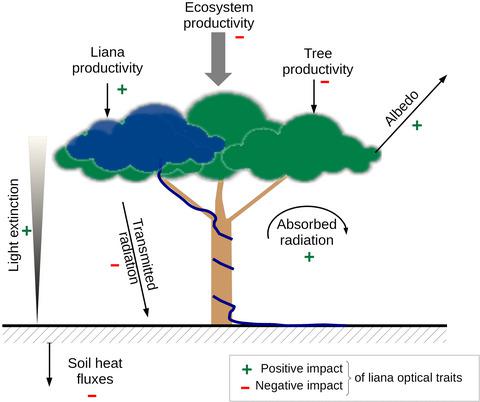当前位置:
X-MOL 学术
›
Glob. Change Biol.
›
论文详情
Our official English website, www.x-mol.net, welcomes your feedback! (Note: you will need to create a separate account there.)
Liana optical traits increase tropical forest albedo and reduce ecosystem productivity
Global Change Biology ( IF 11.6 ) Pub Date : 2021-10-15 , DOI: 10.1111/gcb.15928 Félicien Meunier 1, 2 , Marco D Visser 3, 4 , Alexey Shiklomanov 5 , Michael C Dietze 2 , J Antonio Guzmán Q 6 , G Arturo Sanchez-Azofeifa 6, 7 , Hannes P T De Deurwaerder 3 , Sruthi M Krishna Moorthy 1 , Stefan A Schnitzer 7, 8 , David C Marvin 9 , Marcos Longo 10 , Chang Liu 1 , Eben N Broadbent 11, 12 , Angelica M Almeyda Zambrano 12 , Helene C Muller-Landau 7 , Matteo Detto 3, 7 , Hans Verbeeck 1
Global Change Biology ( IF 11.6 ) Pub Date : 2021-10-15 , DOI: 10.1111/gcb.15928 Félicien Meunier 1, 2 , Marco D Visser 3, 4 , Alexey Shiklomanov 5 , Michael C Dietze 2 , J Antonio Guzmán Q 6 , G Arturo Sanchez-Azofeifa 6, 7 , Hannes P T De Deurwaerder 3 , Sruthi M Krishna Moorthy 1 , Stefan A Schnitzer 7, 8 , David C Marvin 9 , Marcos Longo 10 , Chang Liu 1 , Eben N Broadbent 11, 12 , Angelica M Almeyda Zambrano 12 , Helene C Muller-Landau 7 , Matteo Detto 3, 7 , Hans Verbeeck 1
Affiliation

|
Lianas are a key growth form in tropical forests. Their lack of self-supporting tissues and their vertical position on top of the canopy make them strong competitors of resources. A few pioneer studies have shown that liana optical traits differ on average from those of colocated trees. Those trait discrepancies were hypothesized to be responsible for the competitive advantage of lianas over trees. Yet, in the absence of reliable modelling tools, it is impossible to unravel their impact on the forest energy balance, light competition, and on the liana success in Neotropical forests. To bridge this gap, we performed a meta-analysis of the literature to gather all published liana leaf optical spectra, as well as all canopy spectra measured over different levels of liana infestation. We then used a Bayesian data assimilation framework applied to two radiative transfer models (RTMs) covering the leaf and canopy scales to derive tropical tree and liana trait distributions, which finally informed a full dynamic vegetation model. According to the RTMs inversion, lianas grew thinner, more horizontal leaves with lower pigment concentrations. Those traits made the lianas very efficient at light interception and significantly modified the forest energy balance and its carbon cycle. While forest albedo increased by 14% in the shortwave, light availability was reduced in the understorey (−30% of the PAR radiation) and soil temperature decreased by 0.5°C. Those liana-specific traits were also responsible for a significant reduction of tree (−19%) and ecosystem (−7%) gross primary productivity (GPP) while lianas benefited from them (their GPP increased by +27%). This study provides a novel mechanistic explanation to the increase in liana abundance, new evidence of the impact of lianas on forest functioning, and paves the way for the evaluation of the large-scale impacts of lianas on forest biogeochemical cycles.
中文翻译:

藤本植物光学性状增加热带森林反照率并降低生态系统生产力
藤本植物是热带森林的主要生长形式。它们缺乏自我支撑的组织以及它们在树冠顶部的垂直位置使它们成为资源的强大竞争对手。一些开创性的研究表明,藤本植物的光学特征平均不同于同地树木的光学特征。假设这些性状差异是藤本植物相对于树木的竞争优势的原因。然而,在缺乏可靠的建模工具的情况下,不可能揭示它们对森林能量平衡、光竞争和新热带森林藤本植物成功的影响。为了弥合这一差距,我们对文献进行了荟萃分析,以收集所有已发表的藤本植物叶片光谱,以及在不同藤本植物侵染水平上测量的所有冠层光谱。然后,我们使用贝叶斯数据同化框架应用于覆盖叶子和冠层尺度的两个辐射传输模型 (RTM),以得出热带树木和藤本植物性状分布,最终形成完整的动态植被模型。根据 RTM 的反演,藤本植物长得更薄,叶子更水平,色素浓度更低。这些特性使藤本植物在截光方面非常有效,并显着改变了森林能量平衡及其碳循环。虽然森林反照率在短波中增加了 14%,但下层的光照利用率降低(-30% 的 PAR 辐射),土壤温度降低了 0.5°C。这些藤本植物特有的性状也导致树木(-19%)和生态系统(-7%)的总初级生产力(GPP)显着降低,而藤本植物从中受益(它们的 GPP 增加了 +27%)。本研究为藤本植物丰度的增加提供了新的机制解释,提供了藤本植物对森林功能影响的新证据,并为评估藤本植物对森林生物地球化学循环的大规模影响铺平了道路。
更新日期:2021-12-03
中文翻译:

藤本植物光学性状增加热带森林反照率并降低生态系统生产力
藤本植物是热带森林的主要生长形式。它们缺乏自我支撑的组织以及它们在树冠顶部的垂直位置使它们成为资源的强大竞争对手。一些开创性的研究表明,藤本植物的光学特征平均不同于同地树木的光学特征。假设这些性状差异是藤本植物相对于树木的竞争优势的原因。然而,在缺乏可靠的建模工具的情况下,不可能揭示它们对森林能量平衡、光竞争和新热带森林藤本植物成功的影响。为了弥合这一差距,我们对文献进行了荟萃分析,以收集所有已发表的藤本植物叶片光谱,以及在不同藤本植物侵染水平上测量的所有冠层光谱。然后,我们使用贝叶斯数据同化框架应用于覆盖叶子和冠层尺度的两个辐射传输模型 (RTM),以得出热带树木和藤本植物性状分布,最终形成完整的动态植被模型。根据 RTM 的反演,藤本植物长得更薄,叶子更水平,色素浓度更低。这些特性使藤本植物在截光方面非常有效,并显着改变了森林能量平衡及其碳循环。虽然森林反照率在短波中增加了 14%,但下层的光照利用率降低(-30% 的 PAR 辐射),土壤温度降低了 0.5°C。这些藤本植物特有的性状也导致树木(-19%)和生态系统(-7%)的总初级生产力(GPP)显着降低,而藤本植物从中受益(它们的 GPP 增加了 +27%)。本研究为藤本植物丰度的增加提供了新的机制解释,提供了藤本植物对森林功能影响的新证据,并为评估藤本植物对森林生物地球化学循环的大规模影响铺平了道路。



























 京公网安备 11010802027423号
京公网安备 11010802027423号